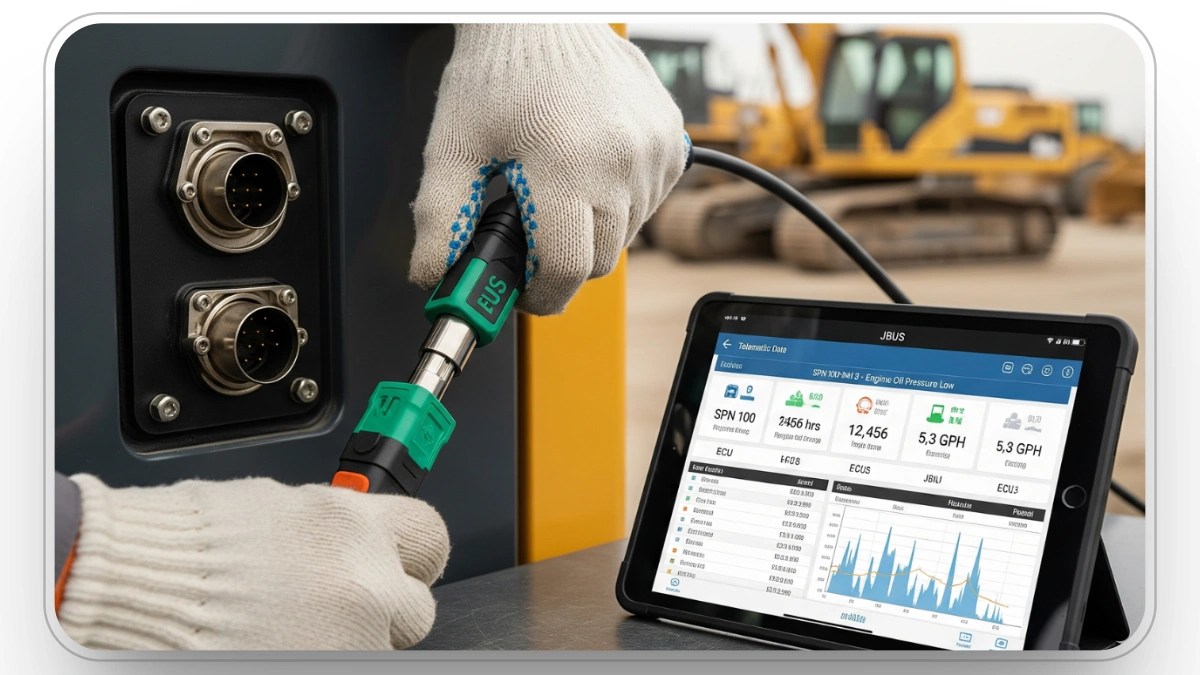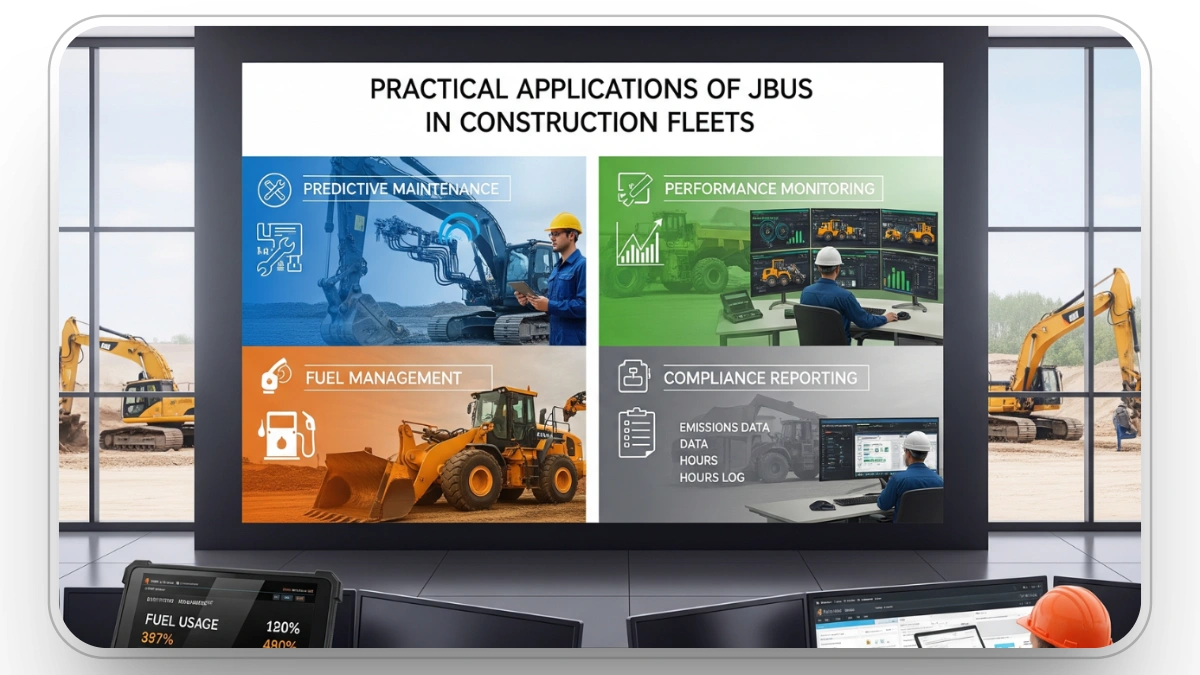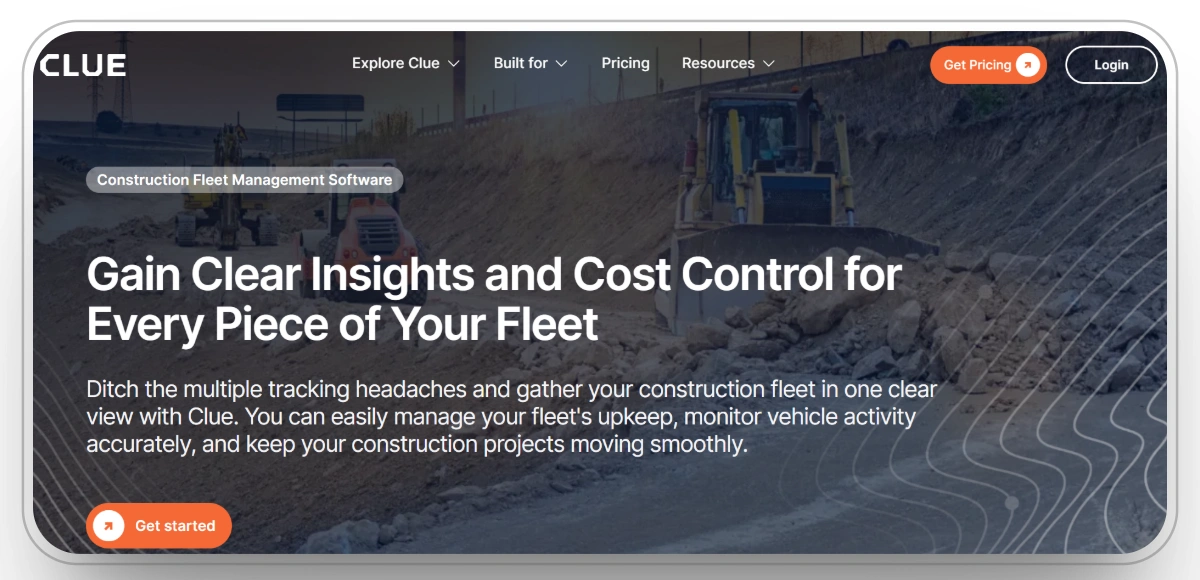JBUS in Construction Fleet Management: The Complete Guide
Data is the most valuable asset in a modern construction fleet to ensure equipment remains operational efficiently, safely, and profitably.
However, you cannot expect all data to be in the same format, and not all communication systems interpret it the same way. In the heavy-duty world, there is one protocol that has been a silent workhorse for decades: JBUS, or SAE J1939.
JBUS is the “language” your loaders, graders, trucks, and other heavy assets use to communicate internally and it’s also how you can access that communication to run your fleet more efficiently. This guide will explain what JBUS is, why it’s important for Construction Fleet Management, how it functions in practice, and what benefits you can expect from using it effectively.
What is JBUS?

To be able to utilize JBUS effectively you must know its purpose.
JBUS or SAE J1939 is a standardized vehicle hardware data communications system (protocol) for heavy duty vehicles and machine equipment. The best way to understand it is to consider it as a common communication language where varied electronic control units (ECUs) in a machine communicate with one another.
Each of the major systems in a modern construction machine engine, transmission, brakes, hydraulics, and emissions controls, has its own ECU. These systems would be left isolated without JBUS. They exchange data via JBUS and each operator, mechanic, and fleet manager can thus detect real-time issues and improve their performance.
Why JBUS Matters in Construction Fleet Management
JBUS is certainly not a small technical detail. It is a direct facilitator of uptime, cost-control and improved decision making in your operations.
By plugging a telematics or diagnostic device into the JBUS port of a machine, you’re no longer limited to the same basic GPS tracking or operator input that most reporting devices provide. This encompasses fault codes, performance surveys, fuel effectiveness data, and loads all to important to maintain equipment fruitful and safe.
Key Benefits
- Comprehensive Diagnostics: ECU data shows specific fault code, sensors anomalies and engine performance anomalies in real time. This enables the maintenance crews to troubleshoot root cause solutions to the minor problems before any major setbacks occur and minimizes downtime and the expensive emergency repairs.
- Operational visibility: Besides GPS location, ECU monitoring offers support of load factor, RPM trends, and mode of operation use. It shows how a piece of equipment is overstressed or underused or used in the wrong way, so managers can distribute assets efficiently and avoid excessive wear.
- Fuel efficiency tracking: Monitor and compare actual fuel burn against idle consumption to spot inefficiencies, identify wasteful operating habits, and develop targeted fuel-saving policies that lower costs and extend equipment life.
- Regulatory compliance: ECU systems log automatically the emissions produced, the after-treatment functionality and engine hours. This guarantees that fleets comply with environmental regulations and safety standards and avoids using manual logs to face the non-compliance fines.
- Maintenance planning: Technicians can use data trends of ECUs to predict component wear, service at the right time and order parts before they break down. This improves the unplanned downtime, maintains the projects on-time, and saves cost of ownership of the equipments.
How JBUS Works in Heavy Equipment
JBUS communication occurs on a Controller area network (CAN) backbone, but with its own set of rules and data formats relative to the heavy duty truck/trailer industries.
Here’s the basic flow:
- Each ECU generates data packets.
- JBUS defines how these packets are formatted and transmitted.
- Data travels over the CAN wiring to other ECUs and to the diagnostic port.
- A connected telematics or diagnostic device reads and interprets the data.
JBUS data is often more detailed and specialized than light-duty OBD systems, especially for things like hydraulic pressure, PTO engagement, and load weights, data that’s mission-critical on a jobsite.
Practical Applications of JBUS in Construction Fleets

The whole concept of JBUS integration is more than having more data, it is taking control of that information and putting it into action.
1. Predictive Maintenance
Using JBUS, you are able to intercept early symptoms of trouble. The temperature may rise in the coolant or the hydraulic pressure sensor may identify an abnormal reading of pressure, thus creating the work order before the problem worsens.
2. Performance Monitoring
Monitoring the level of utilization, inactivity periods, and operator activity are possible. This assists in training and cost saving as well as efficiency in the way the machines are allocated.
3. Fuel Management
JBUS data could demonstrate the actual fuel burn compared with idle consumption such that fleet managers should have fuel saving policy.
4. Compliance Reporting
The compliance reporting can be fed automatically using emissions and run-time data out of JBUS creating less need to manually track.
Challenges and Considerations When Using JBUS
While JBUS offers huge benefits, it’s not plug-and-play without some planning.
- Data overload: Without proper software filters, the volume of raw JBUS data can overwhelm operators and managers.
- Equipment variations: Not all machines output the same data points, even if they use JBUS.
- Interpretation complexity: Raw JBUS messages are coded and require decoding software to be useful.
- Hardware access: You’ll need telematics units or readers capable of J1939 interpretation.
How to Get Started with JBUS in Your Fleet
Part of your fleet may be heavy-duty construction equipment, in which case you probably already have JBUS-capable machines. Then the second step is turning that ability into action.
Step 1: Identify JBUS-enabled assets
The vast majority of modern heavy equipment is manufactured with J1939 9 pin diagnostic connector.
Step 2: Choose compatible telematics hardware
Find devices that will be able to read and interpret the J1939 data points you need to track.
Step 3: Integrate with your fleet management platform
Only useful data is the one that is available and can be acted on. Integration will make JBUS data stream into maintenance, performance dashboards and compliance tools.
Step 4: Train your team
Operators, mechanics, and managers are expected to be familiar with what JBUS data can be accessed and what they can do with them.
Using JBUS Data with Clue for Smarter Fleet Management

JBUS provides you with a goldmine of diagnostics and performance data but the trick is how do you transform that raw feed and translate that into actionable information to share with your operations team.
This is where Clue fills the gap.
Clue’s construction fleet management software will automatically retrieve JBUS information on your equipment and consolidate the information into a single easy to navigate platform.
You no longer have to jump among two or more OEM portals to find all your data and spend time inserting diagnostic tools into individual machines, instead, real-time views of all engines hours, fault codes, fuel usage, and idle time.
- Centralize JBUS Insights in One Dashboard: Clue puts all your JBUS data, snapshots, engine hours, engine fault codes, etc., into one clear interface. No need to access each OEM portal and no more spreadsheets. You get real-time J1939 readings along with asset location, uptime trends and utilizations so you have the whole picture at in a single pane of glass.
- Automate Maintenance from Fault Codes: Clue can auto generate and assign a work order when a JBUS fault code (or performance anomaly) is present. This eliminates the process of scheduling repair after the detection of a defect and lessens manual administrative work, and assists in ensuring fewer small defects to lead to a costly breakdown.
- Maximize Asset Utilization: Clue integrates JBUS telematics framework and live fleet operation to identify underutilized gear, idle abnormalities or ineffective deployment. With access to asset utilization metrics like fuel burn rates, idle hours and load information at your fingertips enables you to redeploy or retire assets to save money and increase the levels of productivity.
- Streamline Compliance and Reporting: Since JBUS automatically documents engine hours, emissions, and other issues involved in legal compliance items, Clue can use those readings and convert it to detailed reports ready to send out. This simplifies the achievement of the regulatory requirements and audits without having to sift through manual logs.
- Integrate with Your Existing Tools: Clue is compatible with 70+ integrations like telematics, GPS, OEM and CMMS. It implies that your data at JBUS such as Caterpillar, John Deere, or Komatsu can be fed into the dashboard where you also monitor, schedule and evaluate cost, without setting up additional accounts.
The Future of JBUS in Construction

JBUS has played a fundamental role in heavy equipment diagnostics over the past decades, but that is changing. Machines grow more interconnected and autonomous functions increase, but JBUS is also a fundamental protocol with newer digital interfaces and cloud-based analysis often being added.
To fleet managers, this denotes JBUS will remain a useful source of insights at the machine level but the analytics to decipher the information and take action will be quicker, smarter and more automated.
Conclusion
A JBUS connection is much more than a tech spec in the documentation of your equipment, it serves as an intermediary between the internal operations of your machines and the practical knowledge you require about their functioning. Once you open this stream of diagnostics, fuel, and performance data, you are not only fixing issues quicker, but also avoid them before they even happen.
This transformation will be a change in reactivity where firefighting to proactive decision-making translates to reduced breakdowns, increased life on equipment and efficient fuel consumption in your fleet.
Once you have JBUS data fully integrated in your fleet management regimes it becomes a multiplier in your sphere and can be used to feed your maintenance schedules, inform your operator training and even ensure regulatory compliance without any additional tedious manual effort.
The businesses which will operate with knowledge of this data in their hands today will be setting the standard tomorrow that other people will struggle to keep up with.
See JBUS insights in action.
FAQs
1. How is JBUS different from other telematics protocols like OBD-II or CAN bus?
JBUS is configured to higher duty cycles and construction equipment and has more equipment specific data like the PTO (power take-off) state, air brake pressure and fault codes. JBUS mostly serves the operational requirements of fleet with large machines and trucks, whereas OBD-II is mostly seen in light vehicles and the CAN bus is a general bus communication.
2. Can JBUS data help with warranty claims?
Yes. JBUS also avails time-stamped diagnostic codes and performance journals, which may be regarded as objective claims upon submitting warranty claims. This can help prevent conflict with dealers or manufacturers and it can also accelerate the speed at which a claim can be approved.
3. What kind of hardware is needed to access JBUS data?
Generally, you will require one J1939 adaptable telematic device or device which you can directly connect to the diagnostic port of the equipment. Most current fleet manager solutions combine the use of these adapters with cloud-based software meaning information is immediately available.
4. Is JBUS data useful for sustainability or ESG reporting?
Absolutely. JBUS can monitor fuel use, idle, and emission based fault codes that can be entered into sustainability measures. This can assist the construction companies to achieve the environmental goals as well as get ready to tougher emissions standards.
Transform Your Equipment Management











